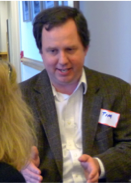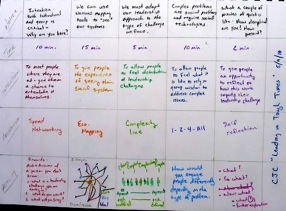Liberating the Courts and Child Welfare Law
(Tim Jaasko-Fisher)
Child welfare law is a high stakes field that can literally mean life or death for a young child,” says Tim Jaasko-Fisher. “Resources are often divided into silos despite the fact that virtually everyone working in the field acknowledges that solving the problem requires cross-discipline collaboration.” The goal is to help families and children in abuse and neglect situations.
 Tim Jaasko-Fisher is a young lawyer passionate about transforming the child welfare legal system. Tim has empathy for the people that feel trapped in a system that is not working well. This includes both people administering the system and those whom it was intended to serve. He believes that local solutions will come from the people doing the work. Based out of the University of Washington Law School, Tim consults with court systems to unleash cross-functional and inter-professional innovation in service of children and families.
Tim Jaasko-Fisher is a young lawyer passionate about transforming the child welfare legal system. Tim has empathy for the people that feel trapped in a system that is not working well. This includes both people administering the system and those whom it was intended to serve. He believes that local solutions will come from the people doing the work. Based out of the University of Washington Law School, Tim consults with court systems to unleash cross-functional and inter-professional innovation in service of children and families.
Composing A Workshop for Leaders
Tim used Design Storyboard to compose a conference session for 70 participants (e.g., judges, lawyers, court clerks, social workers, etc …) involved in children’s justice issues. [Author's note: Designing the session was part of completing a Masters Degree in Organizational Systems Renewal at Seattle University. Keith McCandless sat on his advisory committee over the 18 months.]
![]() Tim wanted the participants involved in the court system to think about their work in a disciplined way. The Design Storyboard helped him draw out the overall intention of the session as well the details of each segment. This included the method of interaction, a time allocation, a success metric and illustrations. The design included
Tim wanted the participants involved in the court system to think about their work in a disciplined way. The Design Storyboard helped him draw out the overall intention of the session as well the details of each segment. This included the method of interaction, a time allocation, a success metric and illustrations. The design included![]() Impromptu Networking, a form of Social Network Webbing, Agreement-Certainty Matrix, and 1-2-4-All.
Impromptu Networking, a form of Social Network Webbing, Agreement-Certainty Matrix, and 1-2-4-All.

Pictured right: Tim's Design Storyboard for leaders in the juvenile justice system. Tim wanted participants to think in a disciplined way, just as he has done with this storyboard. Top-to-bottom headings include: Notice (key insight), Time, Intention, Method, Activity.
Tim recalls his experience, “I had two types of participants: everything is being done TO me participants and engaged leaders who are looking for useful methods. One everything is being done to me participant summed it up succinctly, ‘What can you tell me: my court system is a boat that is on fire, under fire, and taking on water. What can you tell me to do?!’"
It seemed clear to Tim that sharing a rational intellectual framework would not be the most effective approach for this group of people. The second group of engaged leaders were interested in new approaches and understood that letting go of over-control might unleash more positive change.
The session began with Impromptu Networking, not the expected lecture. Tim recalls, “This was not a level of interaction participants were used to in our field, particularly to start a presentation. It set the tone that participants would do the work in this workshop and visibly raised the energy level in the room.” Participants had the opportunity to briefly share with 3 other participants what leadership challenge they wished to make progress on that day, what they hoped to get from the workshop, and what insight they brought to the conversation.
![]() Tim walked participants through a Social Network Webbing (he calls it eco-mapping) early on in the presentation. He notes how powerful it is for people that feel isolated and disempowered to experience interconnectedness among levels and functions in the court system:
Tim walked participants through a Social Network Webbing (he calls it eco-mapping) early on in the presentation. He notes how powerful it is for people that feel isolated and disempowered to experience interconnectedness among levels and functions in the court system:
Often times, there is not a high level of agreement as to what should be done in a case, and the legal portion of the case is seated in a process that is designed to be adversarial by its nature making collaboration difficult at times.”
The mapping process helped people in the court system visualize a pathway that would lead from their isolated position to a collaborative network of people committed to the same issue. It also helped people to see that how they could be successful without authority over the entire process.
Later in the presentation, Tim asked participants to indicate how engaged they were in the workshop by raising their hand: down to the knees meant not at all and above the head meant very engaged. Out of 70 participants, no one was below shoulder level and one judicial officer actually stood on his chair to get his hand higher.
In a final section of the workshop Tim asked people if their leadership challenge was simple, complicated, complex, or chaotic. He invited participants to distribute themselves across the room (front of the room indicated a simple problem back of the room was chaos with appropriate stops in between). This allowed people to see the distribution of the types of problems the group faced. Most of the problems were situated in the realm of complicated and complex.
![]() A 1-2-4-All ignited a conversation about the leadership skills needed each type of challenge. The group noted that as you moved toward the back of the room—from simple to chaos—the degree of social interaction necessary increased. Simple problems could largely be solved with authority and expertise, but complex problems required social interventions, consensus, and dialogue skills. Tim’s design and intention for the workshop made it possible for the group to discover this insight for themselves.
A 1-2-4-All ignited a conversation about the leadership skills needed each type of challenge. The group noted that as you moved toward the back of the room—from simple to chaos—the degree of social interaction necessary increased. Simple problems could largely be solved with authority and expertise, but complex problems required social interventions, consensus, and dialogue skills. Tim’s design and intention for the workshop made it possible for the group to discover this insight for themselves.
Reflections on Design Storyboard
Clearly, the constraints of a Design Storyboard drive Tim’s creativity.
A storyboard helps me and others see patterns in meeting segments. Redundancy and boring patterns are revealed. Talking about collaboration while listlessly watching PPT presentations will not do!“
Beyond a single workshop, Tim’s goal for law students and stakeholders in the courts is to take more responsibility for their own learning. With fervor Tim suggests, “The answers are not scripted. The gestalt and aesthetic of the interaction is revealed. I ask more of myself and more of the people working in the court system.” Apathy is the enemy. Tim says when working with stakeholders on a design, open boxes move the process forward without my intervention in a way that engages all those participating.
‘You tell me, what should go in the box?’”
